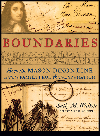
Boundaries
How the Mason-Dixon Line Settled a Family Feud and Divided a Nation
فرمت کتاب
ebook
تاریخ انتشار
2014
Lexile Score
1190
Reading Level
7
ATOS
8.7
Interest Level
9-12(UG)
نویسنده
Sally M. Walkerناشر
Candlewick Pressشابک
9780763670368
کتاب های مرتبط
- اطلاعات
- نقد و بررسی
- دیدگاه کاربران
نقد و بررسی

January 20, 2014
Walker (Secrets of a Civil War Submarine) presents an exhaustively researched account of the people and events surrounding the creation of the Mason-Dixon Line. The author goes back to 16th-century England when the Calvert and Penn families were granted charters for the Maryland and Pennsylvania colonies, respectively. Using the boundary metaphor extensively, the packed-with-facts narrative covers historical, political, religious, geographical, and scientific terrain. The bulk of the story takes readers step by chronological step through Charles Mason’s meticulous astronomical observation work and Jeremiah Dixon’s laborious ground survey in the 1760s as they delineate a boundary that would take on increased significance in the run-up to the Civil War. Thirteen chapters include breakout sidebars that thoroughly contextualize the Mason-Dixon Line, from information on celestial navigation and the Quaker religion to the Fugitive Slave Act of 1850 and sidereal time. Scientific and mathematical concepts are clearly presented and well-defined, but may make for more challenging reading. Archival photos, maps, and diagrams supplement the text, as do extensive source notes, a bibliography, and an index. Ages 10–up.

ikyra_marie - Cool we are learning about this in history a little.

March 1, 2014
Gr 9 Up-With her book title reflecting both theme and structure, Walker begins with the English religious boundaries that drove the Catholic Calvert family and Quaker William Penn to seek religious freedom in their respective New World colonies of Maryland and Pennsylvania. Conflicting royal land grants and imprecise surveys led to a disputed boundary between the colonies, eventually resolved by an accurate land survey conducted by British scientists Charles Mason and Jeremiah Dixon. Much of the book describes their work, one of the most technologically challenging surveys done to that point. The author concludes with a discussion of how their survey line became a physical and symbolic boundary that marked the divisions in pre- and post-Civil War America, concluding that it remains a representational historic link to contemporary physical and cultural boundaries. Walker's account, supplemented with numerous illustrations and maps, of the conflicts along the disputed boundary and Mason and Dixon's innovative methods of scientific surveying is comprehensive and objective but is occasionally dry, and some of the complex scientific and technical concepts will be too difficult for middle school readers. Her emphasis on the survey provides a perspective missing in titles such as John C. Davenport's The Mason-Dixon Line (Chelsea House, 2004), which focuses on the line's political and military role in the antebellum slavery debate and Civil War and the postwar cultural division between North and South. While the topic won't draw a large audience, its importance in American history makes this book a strong report choice about the boundaries that shaped our nation or science in early America.-Mary Mueller, Rolla Public Schools, MO
Copyright 2014 School Library Journal, LLC Used with permission.

January 1, 2014
In this richly layered, thoroughly researched history of the Mason-Dixon Line, Walker crisscrosses the boundaries of geography, culture, economics, science, mathematics, politics and religion to reveal that drawing lines is as likely to cause conflict as settle it. The story of the boundary lines surveyed between 1763 and 1767 by Charles Mason and Jeremiah Dixon is just one thread of this sweeping historical chronicle. The storied boundary is most associated with the divide between the North and the South and the bloody history wrought by that line, but Walker reveals a fascinating and complicated history of exploration, family feuds, persecution, ideological conflicts, scientific experimentation and advancement, and the forging of a national identity. Beginning in the 16th century and ending in the present, the account of the Mason-Dixon Line often serves as a window into some of the pivotal developments of American history. The author ably makes the case that "[t]he many boundary journeys found in the complete story of the Mason-Dixon Line are relevant today." Abundant use is made of quotations from primary sources, and many photographs and archival images enrich the narrative. A thoughtful, insightful, challenging and extensively researched chronicle of United States history and the shaping of national identity from a unique perspective. (maps, photographs, source notes, bibliography, index) (Nonfiction. 12 & up)
COPYRIGHT(2014) Kirkus Reviews, ALL RIGHTS RESERVED.

February 1, 2014
Grades 8-12 This thoroughly researched account of the MasonDixon Line encompasses a broad span of time and place, from sixteenth-century England to twentieth-century America. Walker, who wrote the Sibert Award winner Secrets of a Civil War Submarine (2005), opens with generations of the Calvert and the Penn families in England, leading up to their founding the colonies of Maryland and Pennsylvania. After many border disputes, a commission hired Englishmen Charles Mason and Jeremiah Dixon to set the boundary between the colonies. Using their skills in astronomy, mathematics, and surveying, they completed the task in 1768. One interesting section of the book involves the negotiations necessary before Mason and Dixon could extend their survey into Native American territory. Illustrations include maps, period documents, and photos of sites and artifacts. Many students will find the text challenging to read, particularly the sections explaining the techniques and tools that Mason and Dixon used to determine the line's exact location. Walker's latest book offers a good deal of pertinent information on the subject at hand, as well as some interesting sidelights on American history.(Reprinted with permission of Booklist, copyright 2014, American Library Association.)

























دیدگاه کاربران